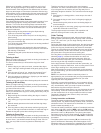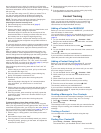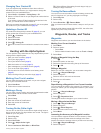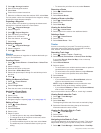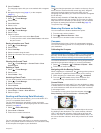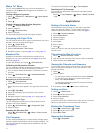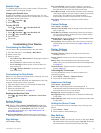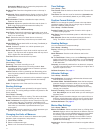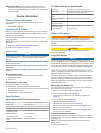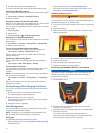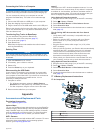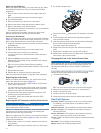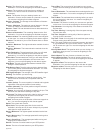
Removing the Old Battery
Before you replace the battery, you must remove all dirt, water,
and debris from the device. Also, you need a small Phillips
screwdriver.
1
Remove the six screws from the outer edges of the back
plate.
TIP: You should leave the two inner screws in place.
2
Pry off the back plate.
3
Disconnect the four-pin and five-pin connectors.
4
Remove the three screws that secure the battery cover.
5
Remove the battery cover and the battery.
Remember the orientation of the battery. You must install the
new battery the same way.
After you remove the old battery, contact your local waste
disposal department to properly recycle the battery.
Installing the New Battery
Before you replace the battery, you must remove the old battery
(page 18). You also need a small Phillips screwdriver. You may
need a small flat screwdriver to connect the connectors.
1
Install the new battery with the connector on the end nearest
the Power key.
2
Replace the battery cover.
3
Replace the three screws to secure the battery cover.
4
Connect the five-pin and four-pin connectors.
You may need to use a flat screwdriver to help secure the
connectors.
5
Select the Power key to test the connections.
When properly connected, a tone is emitted and the status
LED blinks green.
TIP: You can turn off the device before proceeding.
6
Make sure the gasket located inside the bottom cover is fully
seated.
7
Replace the back plate.
8
Replace the six screws to secure the back plate.
After you install the new battery, charge the collar completely.
Replacing the Collar Strap
Before you replace the collar strap, you must remove all dirt,
water, and debris from the device (page 15).
1
Pull the collar strap out of the GPS antenna, VHF antenna
guide, and the dog device.
You may need to push and pull the collar strap to properly
remove it. You may need to loosen the screw on the GPS
antenna case, but do not remove them.
2
Thread the new collar strap through the dog device, VHF
antenna guide, and GPS antenna.
3
If necessary, tighten the screws that secure the GPS
antenna case.
Replacing the VHF Antenna in the Dog Collar Device
NOTICE
Do not excessively bend the band that connects the main
device case with the GPS antenna.
When the L-shaped cover is removed, do not disturb the sealant
opposite the VHF antenna, because this can damage the
waterproof seal of the dog collar device.
Before you replace the VHF antenna, you must remove all dirt,
water, and debris from the device (page 15). Also, you need a
small Phillips screwdriver.
1
Remove the 4 screws
À
from the L-shaped cover over the
VHF antenna.
NOTE: You should note the location of the one short screw.
2
Pry off the L-shaped cover.
3
Remove the screw
Á
securing the VHF antenna to the back
plate.
4
Pull the length of the antenna from the antenna guide to
remove the old antenna.
5
Loop the antenna guide around the collar strap, and thread
the new VHF antenna through the guide.
This helps to point the antenna up.
6
Replace the screw securing the VHF antenna to the back
plate.
7
Replace the L-shaped cover over the VHF antenna.
8
Replace the 4 screws on the L-shaped cover, replacing the
short screw in the correct location.
Changing the Fuse in the Vehicle Power Cable
NOTICE
When replacing the fuse, do not lose any of the small pieces
and make sure they are put back in the proper position. The
vehicle power cable does not work unless it is assembled
correctly.
If your device does not charge in your vehicle, you may need to
replace the fuse located at the tip of the vehicle adapter.
1
Unscrew the end piece
À
.
TIP: You may need to use a coin to remove the end piece.
2
Remove the end piece, the silver tip
Á
, and the fuse
Â
.
3
Install a 2 A fast-blow fuse.
4
Place the silver tip in the end piece.
5
Screw the end piece back into the vehicle power cable
Ã
.
Data Field Options
Accuracy of GPS: The margin of error for your exact location.
For example, your GPS location is accurate to within +/-
12 feet (3.65 m).
Ambient Pressure: The uncalibrated environmental pressure.
Ascent - Average: The average vertical distance of ascent
since the last reset.
Ascent - Maximum: The maximum rate of ascent in feet per
minute or meters per minute since the last reset.
Ascent - Total: The total elevation distance ascended since the
last reset.
Barometer: The calibrated current pressure.
Battery Level: The remaining battery power.
18 Appendix



